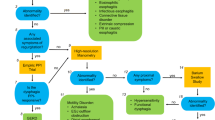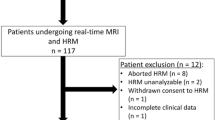Abstract
Purpose
To evaluate the feasibility of detecting and measuring gastro-esophageal reflux (GER) with esophageal MR fluoroscopy in patients suffering from heartburn.
Materials and methods
Twenty patients with heartburn underwent esophageal MR fluoroscopy. The T1-FFE sequence was applied for MR imaging. We examined the frequency and the level of GER on MR images. Based on the MRI observations, patients were classified into four MRI grades (grade 1–4). Endoscopic findings were categorized into five grades (grade 0 to D). The overall MRI grade, Carlsson’s questionnaire score, and endoscopic findings were compared.
Results
GER was observed with MR fluoroscopy in 19 of 20 patients. GER was observed only several times in three patients, and much more frequently in the remaining 16 patients. Elevated levels of GER reached the lower, middle-to-upper esophagus, and the hypopharynx. The observed MRI grades were grade 1 = 1 patient, grade 2 = 3 patients, grade 3 = 2 patients, and grade 4 = 13 patients. There was no statistical correlation between the questionnaire score and the MRI grade. Also, there was no correlation between the grade of endoscopic findings and MRI grade. Six patients demonstrated continuous reflux on MRI did not show mucosal injury at endoscopy.
Conclusion
Esophageal MR fluoroscopy may be a useful diagnostic tool for GERD for its ability to show GER, even in patients with no mucosal injury, and for suggesting the cause of the reflux.



Similar content being viewed by others
References
Nakamura K, Shiojima J, Kurosawa S, et al. (1999) GERD and its symptoms. In: Kogure T, Hoshihara Y, (eds). Gastroesophageal reflux disease. Tokyo: Medical Review, pp 13–23
Fijimoto K, Iwakiri R, Okamoto K, et al. (2003) Characteristics of gastroesophageal reflux disease in Japan: increased prevalence in elder women. J Gastroenterol 38:3–6
Tomoko M, Kawamitsu H, Higashino T, et al. (2004) Esophageal magnetic resonance fluoroscopy: optimization of the sequence. J Comput Assist Tomogr 28:697–703
Carlsson R, Dent J, Bolling-Sternevald E, et al. (1998) The usefulness of a structured questionnaire in the assessment of symptomatic gastroesophageal reflux disease. Scand J Gastroenterol 33:1023–1029
Armstrong D, Bennett JR, Blum AL, et al. (1996) The endoscopic assessment of esophagitis: a progress report on observer agreement. Gastroenterology 111:85–92
Labentz J, Blum AL, Bayerdorffer E, et al. (1997) Curing Helicobacter pylori infection in patients with duodenal ulcer may provoke reflux esophagitis. Gastroenterology 112:1442–1447
Dodds WJ, Dent J, Hogan WJ, et al. (1982) Mechanism of gastroesophageal reflux in patients with reflux esophagitis. N Engl J Med 307:1547–1552
Paul NM, Jeffery JB, Peter FH, et al. (2000) The clinical value of ferric ammonium citrate: a positive oral contrast agent for T1-weighted MR imaging of the upper abdomen. J Magn Reson Imaging 12:702–707
Author information
Authors and Affiliations
Corresponding author
Rights and permissions
About this article
Cite this article
Manabe, T., Kawamitsu, H., Higashino, T. et al. Observation of gastro-esophageal reflux by MRI: a feasibility study. Abdom Imaging 34, 419–423 (2009). https://doi.org/10.1007/s00261-006-9093-0
Published:
Issue Date:
DOI: https://doi.org/10.1007/s00261-006-9093-0




